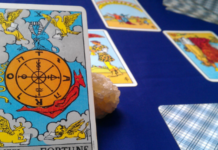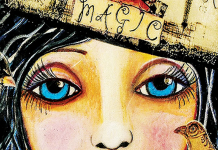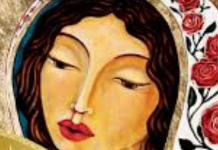 Visconti Tarots Kit, illustrated by A. A. Atanassov, companion book by Giordano Berti and Tiberio Gonard
Visconti Tarots Kit, illustrated by A. A. Atanassov, companion book by Giordano Berti and Tiberio Gonard
Kit: Lo Scarabeo/Llewellyn Wordlwide, 0738702935,78 (+2) (deck), 159 pp. (book), 2002
The kit edition of the Visconti tarot published by Lo Scarabeo and distributed by Llewellyn Worldwide in North America, consists of a 78 card tarot deck, accompanied by a book of the same name detailing a brief history and descriptions of the cards.
Berti notes in the introduction that ‘today, in private collections, museums and libraries in Europe and America there are still sixteen packs of tarot cards attributed to Visconti commissions, but as he states “none of them are complete, unfortunately.”1 However, the Visconti decks of the Milanese court provide examples of some of the oldest surviving tarot decks.Giordano Berti
The deck which formed the primary inspiration for the Visconti tarot deck presented here is the Visconti-Sforza pack, or the Francesco Sforza Tarot Cards, to give it its other name, the most complete of which consists of “seventy-four cards now divided between the Pierpont Morgan Library in New York, the Carrara Academy in Bergamo and the Colleoni family.”2 The original is popularly thought to have been painted by Bonifacio Bemo, however this deck is a recreation painted by A. A. Atanassov; it is not a reproduction.
The history presented in the introductory chapters is brief, but more or less relates to the history as presented by modern scholars and historians; however the divinatory section of the book, which makes up the bulk of the text, is somewhat sketchier.
While Gonard notes that the cards were not used for divining in the Visconti court, nonetheless, that is precisely what he offers here. Further, he states: “Personally, I do not think I have strayed far from what must have been a fifteenth-century man’s interpretation of these images as he handled them. I have then compared this historical information with traditional cartomancy, by which I mean the divinatory meanings that have entered into current use, and without too much effort I have been able to ascertain that a certain coherence exists.”3 Unfortunately that is not clear from the text he delivers, nor is it clear whether or not Gonard himself practices Tarot divination, which could explain his presentation of the material.
Following the history lesson are some notes on the art of divination, accompanied by quite a number of spreads, far more than typical for an extended ‘little white book’, and these may offer welcome ideas for those new to Tarot, though hopefully new students won’t be bogged down by the strict shuffling methods given here.
There is a short note on diviners’ ethics which contains points which are promptly refuted in the following chapter entitled “Answers to possible objections” (essentially a brief FAQ). For example, in the ethics section he notes that ‘the diviner must not be inspired by any religious or philosophical belief, nor by any rational conviction…”4 but a mere two pages later in the section on questions and answers he states that “…many cartomancers consecrate their cards during mass, although secretly; many pray in a Christian way at the beginning of a session; many live a Christian life and die receiving the sacraments.”5
As a practicing tarot consultant myself I take issue with both points raised here. Every reader is going to be coloured by her or his beliefs and teachings, it’s only natural, and while some Christian readers may consecrate their decks at their churches, it is equally likely that a Wiccan reader will consecrate a deck as deemed fit – and I find neither practice immoral or unethical. Gonard seems to be favouring a Christian religious bias to allay Christian fears regarding the art, thus implying that as some Christians consult the cards it becomes more right, somehow, than if other religious or irreligious practitioners were reading. It’s this sort of attitude that continues to foster this slightly shifty or sinister reputation in regards to divination and it has no place in an instructional booklet on Tarot. Better to state that anyone can read the cards, regardless of religion or creed or lack thereof, than to try and express it in terms of Christian acceptance to the exclusion of other practitioners.
It’s unclear whether it is the translators or Gonard himself who give the English names for the cards with their modern esoteric associations which have been derived from Court de Gébelin and those who came after him. Therefore the Juggler or Mountebank becomes the Magician, the Papess becomes the High Priestess, Time the Hermit, and so forth. This is also reflected in the pip and court cards, here referred to as Wands, Chalices, Swords and Pentacles. Further, no note is made of the order of the cards. In the original order of the cards the Swords and Batons went from King, Queen, Knight, Page, ten to ace; and Cups and Coins went form King, Queen, Knight, Page, ace to ten. This was standard for Italian card games of the period. However, the cards are presented here in their typical esoteric fashion, from ace to ten, Page, Knight, Queen and King.
He notes that he thought it better not to ‘spend so much time on the iconographic analysis of the number cards and court figures that make up the Visconti Tarots…It is not that there are no elements that characterise this pack from other tarots, but it is undeniable that the Minor Arcana in this back do not offer so many stimuli for the study of particular allegorical meanings’6, as such the trumps are afforded two pages, and the pips and court cards receive one each.
Each card is accompanied by a brief description of its figures and divinatory meanings for interpretation, both upright and reverse. However there is little on the allegorical meanings of each of the images and objects depicted in the cards, and as such the divinatory meanings seem to hold little weight, as they merely consist of a list of keywords often with little connection or direct association to the cards.
There are a great number of discrepancies in the text presented and in the images reproduced in the deck and accompanying book. For example, in his introduction, Berti notes that ‘the suit of Pentacles has been engraved with either one or the other face of Filippo Maria’s gold florins’, yet this image does not appear in this deck, though the Visconti motto does appear on cards two through five.
Many of the descriptions Gonard gives do not match the present deck of cards, nor in the illustrations given in the accompanying booklet. For example he notes a sceptre in the Empress’ hand, an arrow in Death’s, and a coral necklace which does not appear on the Sun card. The scrolls noted in his description of the Wheel of Fortune are blank, rather than depicting the text given in the book, nor are the animal characteristics described represented as he states.
Gonard states that “Wands refer to money, Pentacles to business, Chalices to love, and Swords to legal or health questions.”7 These virtues are not present in this version of the Visconti Tarot, though Gonard believes that the High Priestess (Papess) depicts Faith. It’s an interesting notion, but with no representation of the other theological virtues it cannot be placed in its proper context.
While Gonard takes note of the symbols of the Visconti and Sforza houses in the Empress, he comments on the “wings” of later versions, however these were not “wings,” but the design of the throne upon which she sat. He also relates Strength – here depicted as a man clubbing a lion – to one of the cardinal virtues, but as the virtues were commonly represented by women it seems unlikely in this case. Though he has accurately restored the Hanged Man with its original, intended meaning, as the Traitor. The Devil and Tower were lost from the deck, and have been reconstructed from designs of a similar time period.
The five of Swords is explained using the five limbs of attachment of Buddhism, and cards eight and nine of the Wands also speak of the lotus flower and other depictions of Buddhism. Whether or not these interpretations lend insight into the Tarot in general remains to be seen, but to claim that these are ideas that would have been present in the average Renaissance man’s mind seems unlikely.
The gold foil adds a dazzling effect to the cards, many of which are quite fetching. Though clearly some liberties have been taken in this reproduction, comparisons have shown that while it may not be a faithful reproduction, it is quite a good likeness. The deck is lovely, and Tarot collectors are apt to enjoy the deck, though I don’t recommend the accompanying book to new students as a learning aid.
- p. 10 [↩]
- p. 12 [↩]
- p. 22 [↩]
- p. 27 [↩]
- p. 29 [↩]
- p. 101 [↩]
- p. 40) I’m unfamiliar with some of these particular associations; for example Pentacles typically refer to money matters; as the suit originally depicted coins this makes more sense. Unfortunately, while there is a bibliography at the end of the book, there are no notes or citations to tell which information came from where, and which he is merely ‘intuiting’.
Berti notes that the “Visconti di Modrone cards feature a unique characteristic in that they show unconventional subjects like the three theological virtues: Faith, Hope and Charity.” ((p. 11 [↩]








